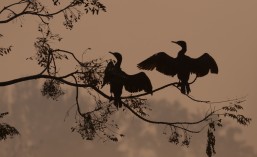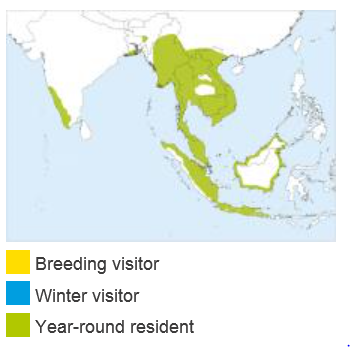Order: Piciformes Family: Picidae Conservation Status: Least Concern
Synonyms: Common Goldenback
Description:
The Common Flameback is a medium sized woodpecker measuring 28 to 30 cm in length and weighing 67 to 90 grams. Adult birds are sexually dimorphic.
The adult male has an olive coloured back which sheens with a golden wash. The back feathers are edged with yellow and often have tinges of red or orange. The hind neck and upper mantle are black whilst the lower back and rump are bright red. The tail is black and the upper-tail coverts are blackish-brown, tinged with olive. Flight feathers are also blackish brown. The underparts are white with black scaling, which is most conspicuous on the breast. The underwing is brown with white spots and the under-tail is blackish brown.
The crown and crest of the head are red and finely lined with black. The forehead and upper lores are red-brown. The side of the head is white with a black stripe running from the eye to the nape and with a black moustachial stripe extending to the upper breast. A broad white stripe extends from the lores down to the sides of the neck and breast. The chin and throat are off-white and are spotted with small black dots. The bill is relatively short and is blackish with a pale base. The eyes are brownish with a narrow black eye-ring. Legs and toes are grey-brown with a greenish tinge.
The female adult is very similar to the male but with an overall duller appearance and a black crown and crest which are finely streaked with white.
Juvenile birds resemble adults and are also sexually dimorphic. Generally juveniles have a blackish-brown breast with white spots and greyer eyes when compared to the adult. Juvenile males have a black forehead and crown, only the crest is red. Juvenile females have pale streaks on their crowns.
Call and Vocalisation:
The Common Flameback has a range of calls ranging from an inflight “kwop-owp-owp-owp” to a “kow-kow” when perched. As with other woodpeckers it can also be heard drumming against tree trunks.
Common Flameback call
Common Flameback song
Range and Distribution:
The Common Flameback is found from South Asia (India, Bangladesh) through to South East Asia (Myanmar, Laos, Cambodia, Thailand, Vietnam, Singapore, Malaysia, Philippines and Indonesia). Within this range the species is resident.
There are five recognised subspecies:
ssp. malabaricum – found in southwest India
ssp. intermedium – found in north east India, Bangladesh, south-central China, through Indochina and Myanmar
ssp. javanense – found through peninsular Malaysia to Sumatra, western Java, Borneo and the Riau Archipelago
ssp. borneonense – found in north east Borneo and the associated offshore islands
ssp. exsul – found in eastern Java and Bali

